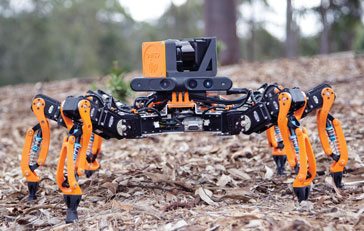Revolutionizing Robotics
The Commonwealth Scientific and Industrial Research Organization (CSIRO) is one of the world’s largest and most diverse scientific agencies. Researching in a variety of disciplines, CSIRO develops robotic devices that touch agriculture, energy, manufacturing, and aerospace industries. 3D printing has played a key role in CSIRO’s Autonomous Systems Lab since 2011 by helping to accelerate research and reduce costs. Over the course of many studies, researchers at CSIRO have developed testable prototypes that were held together with double-sided tape or zip ties due to traditional fabrication methods being too costly or time-consuming. Paul Blick, Senior Mechatronic Engineer at CSIRO began using FDM and Polyjet 3D printing technologies to streamline their prototype production where researchers were enabled to create models quickly and in-house. “Efficiency has been a huge factor contributing to the success of a research project for us, and 3D printing has been the integral accelerator for some of our projects with its highly reliable technology and durable ABS materials,” Flick said. FDM allowed CSIRO to build durable prototypes with mechanically strong, production-grade thermoplastics for projects that required higher tensile or impact strength. Polyjet came in hand when models required fine details and functionality.
“At CSIRO, research is a religion as we endeavor to improve people’s living standards by investigating science and nature. 3D printing has been an indispensable tool and the driving force that helps us prototype better and faster.”- Paul Flick, Autonomous Systems, CSIRO
This agility sped the development of a GPS-enabled cattle monitoring sensor. A key goal was to design a collar that could house the solar panels, electronics, and batteries while withstanding the rough movements of the animal. This system tracks the movement of the cow via GPS, accelerometer and barometer information that is then transferred to a base station for studies. Finalizing this design took many iterations that would have taken the team weeks or even months using a traditional fabrication method. Instead, it took only days to print, assemble and test to confirm the design using 3D printing, allowing the team to begin developing the data-reading parameter ahead of schedule.
For CSIRO, efficiency has been the biggest factor contributing to their success. 3D printing with both FDM and Polyjet technology has been the integral accelerator for their projects and it continues to be the driving force behind their research and innovation today.
